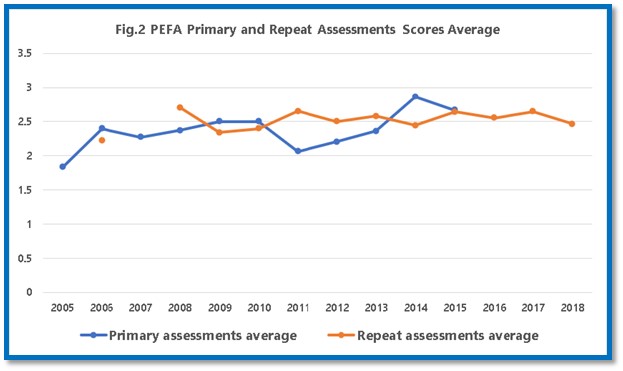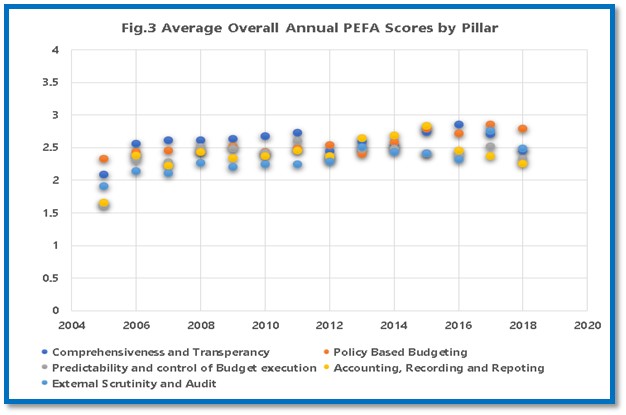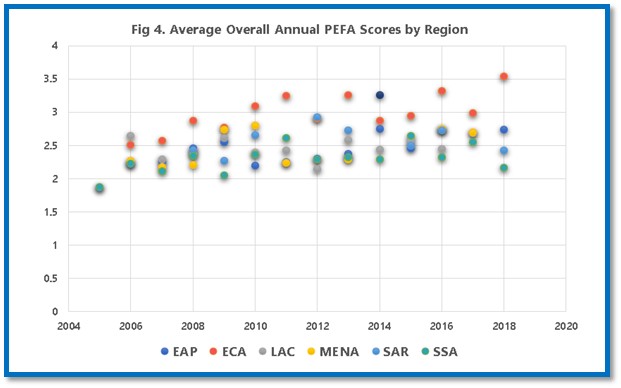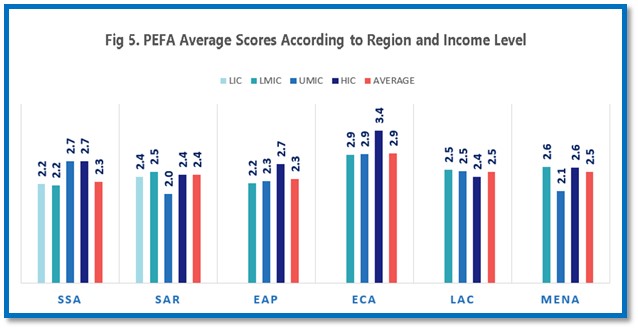A question frequently asked by researchers and experts is whether PEFA scores over the last two decades show an improvement or a decline in overall PFM performance. The simple answer to the question, is yes, average PFM performance has improved moderately and there are opportunities for further accelerating the pace of reforms.
There are plenty of data to reflect upon. Since 2005, 365 national PEFA reports have been finalized and 284 are already published on the PEFA Website. The scores of PEFA assessments attract the attention of reserachers and experts, raising the question of how to interpret these data and trends. In this article we present some preliminary findings that may be of interest to policy makers, practitioners and researchers.
This blog specifically looks at data from 2005-2018 to reflect on past trends. In analyzing the tends in average PEFA scores over the period 2005-2018, the 2011 PEFA methodology has been used. 315 national PEFA assessments were completed during this period. Scores range from 1 to 4 . A score of 2 reflects the basic level of performance for each indicator and dimension, consistent with good international practices.
Figures 1-5 below present some results of this analysis.





Some conclusions are as follows:
- Overall average PEFA scores increased moderately during the period 2005 to 2018 - see Figure 1.
- The pattern of average scores for first and repeat asessments is similar - Figure 2.
- Scores for individual pillars vary widely with comprehensiveness and transparency generally the highest scoring indicators and external scrutiny and audit generally the lowest rated - Figure 3.
- Accounting, recording and reporting indicators generally show the greatest variance in scores.
- Average scores vary substantially by region, from 2.3 for Sub-Saharan Africa and East Asia and the Pacific to 2.9 (close to good performance) for Europe and Central Asia. The dispersion between the best performing and worst performing regions appears to have increased over the years - Figure 4.
- Unsurprisinlgly, high-income countries[1] generally perform better than other countries with an average score of 2.7 overall and 3.4 in the Europe and Central Asia region. Low and middle-income countries have an average score of 2.5, with the best results for countries in Europe and Central Asia and the Middle East and North Africa. Scores for low-income countries are generally withi the 2.2 to 2.4 range. Countries in Latin America and the Caribbean show the most stable average scores for all income levels - Figure 5.
Some countries have shown a substantially better performance than the general trend, with improvements of up to 0.5 points in their average PEFA scores since the mid-2000s. These improvements are noticed across all regions.
Key messages:
- Average scores for PEFA assessments increased moderately throughout the period 2005 – 2018, but there are wide variations across regions and from country to country. Some countries have performed significantly better than average.
- A good proportion of PEFA evaluations were repeat assessments which focus on whether performance has improved since the previous assessment and potential areas for further development. Countries that have not yet undertaken such assessments should consider doing so.
- Researchers should be encouraged to conduct more detailed analysis of the substantial and expanding volume of data on PFM performance. These data can be accessed on the Assessments Portal of the PEFA webpage ( https://www.pefa.org ). The 2022 Global Report on Public Financial Management available in English, French and Spanish is a good starting point for researchers to further analyze PFM performance.
[1] Economies are divided among income groups according to 2018 gross national income (GNI) per capita, calculated using the World Bank Atlas method. The groups are as follows: low income, US$1,005 or less; lower middle income, US$1,005-3,956; upper middle income, US$3,956–12,235; and high income, US$12,236 or more.





